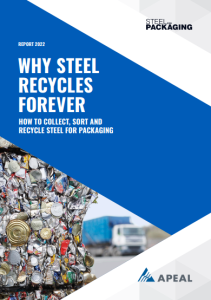APEAL publishes report into steel recycling best practice
‘How to recycle steel – why steel packaging recycles forever’ follows the Association’s first report, launched in 2018: ‘Good practices on separate collection, sorting and recycling of steel for packaging’, which was well-received across Europe.
With an average of 84% recycled across Europe in 2019, steel packaging is already the most recycled primary packaging material in Europe, bringing strong emissions savings, resource and energy use. Steel’s unique inherent qualities also give it a natural advantage. Magnetic properties make it easy and economical to recycle steel, as there is no need for a specific sorting process. As a permanent material, steel can be recycled forever without loss of quality.
“Our new report focuses on best practice in four key areas: optimised separate collection; collection and sorting of steel closures; scrap quality standards, and design for recycling,” said Alexis van Maercke, secretary-general of APEAL.
“It provides updated information relevant to all organisations and stakeholders, both in the public and private sector, wishing to learn more about a real and successful material recycling story. The objective is to help stakeholders throughout the value chain work collaboratively and to achieve APEAL’s vision of zero steel packaging to landfill by 2025.”
Scrap steel is also a key part of the production process of new steel, so every single steel plant in Europe is also a recycling plant, saving resources, energy and emissions by recycling steel in a simple and efficient process. But APEAL believes more can be done.
“Steel for packaging is a resource far too valuable to be wasted if Europe is to achieve the ultimate aims of the Green Deal,” said van Maercke. “This new report shows how the unique properties of steel, alongside the commitment of our industry, can bring us one step closer to achieving a more circular economy.”











